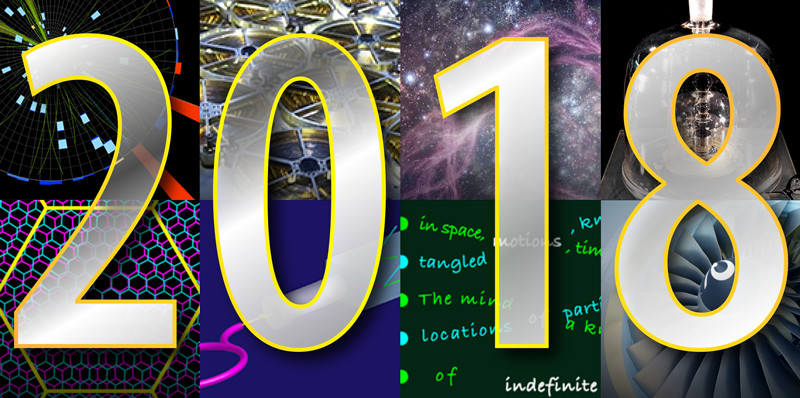Physical results of the year
New Year's holidays are coming to an end, which means it's time to take stock of the year together with the American physical community . The year turned out to be interesting on all fronts - both fundamental discoveries and technical achievements.
Discovery of the year: superconductivity in graphene

Perhaps the main discovery of the year was the superconductivity of double-layer graphene . The essence is simple: a graphene sheet is taken, another sheet is placed on it, rotated at a slight angle. With a “magic” angle of about 1.1º, the structure becomes superconducting at about 1 K. This temperature is too low for any practical applications, and the opening pulp is completely different: it turned out that superconducting two-layer graphene behaves exactly the same as high-temperature superconductors.
It is worth recalling here that the nature of high-temperature superconductivity is still not clear, and it was observed only in complex crystals of the type YBaCuO. To model such a substance in order to understand what is happening in it is an almost overwhelming task. Therefore, the fact that an incomparably simpler graphene can shed light on the half-century riddle of nature is more than a pleasant surprise. And it is much more convenient to work with graphene - it can be placed in magnetic / electric fields, rotated at different angles, all this has been done more than once and well studied, so there is something to compare with.
There is no clear understanding of what is happening yet, but the basic idea is clear: the imposition of two sheets of graphene forms a complex pattern that repeats at a distance of tens of atoms (the yellow lines in the picture). This creates a periodic superlattice that affects the energy zones of graphene and leads to superconductivity at the “magic” angle. Dozens of scientific groups around the world have already picked up work with double-layer materials, and it seems that in the coming years we will see some really interesting results.
Surprise of the year: neutrino oscillations
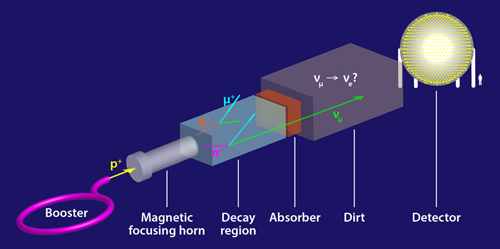
Neutrinos are ultralight elementary particles that often appear during nuclear reactions. At present, we know three types of neutrinos (electron, muon and tau neutrinos). And they can “turn” from one type to another on the fly - this wonderful effect is called neutrino oscillations (there was a good review on Habré ), and its discovery was marked by the 2015 Nobel Prize.
This time interesting news came from Fermilab . In the MiniBooNE experiment, muon neutrinos were generated and their transformation into electronic ones was studied. It turned out that neutrino oscillations occurred much more often than expected. One of the simplest explanations is the existence of a fourth type of neutrino, the so-called sterile neutrino . Unlike other types, sterile neutrinos interact with the surrounding matter only through gravity (therefore, it is almost impossible to detect them directly), but they can influence the frequency of neutrino oscillations.
In principle, such theories have long been known; However, the introduction of a new type of neutrino rather strongly changes the Standard Model of Elementary Particles. Specific experiments are currently being planned (MicroBooNE in Fermilab, DANSS at Kalinin NPP), and the question of sterile neutrinos is still open.
Riddle of the Year: Dark Matter

As we know, a significant part of the Universe consists of dark matter - an invisible substance of incomprehensible nature, which makes up the bulk of galaxies. For a long time, the main candidate for the role of dark matter was WIMPs - unknown massive elementary particles interacting with the outside world only through gravity (for example, the aforementioned sterile neutrinos). A lot of different detectors were built for their search, but none of them brought positive results, so now interest is gradually shifting to other possible explanations.
The simplest alternative put forward by Hawking half a century ago would be black holes - they are massive and invisible. For example, primary black holes with masses from 10-8 to 10 solar masses could have been formed at the beginning of the Universe, before the appearance of atoms. If such objects exist, then from time to time we must observe how they pass through visible disks of stars, distorting their shape and brightness due to gravitational lensing .
In one of the works of the last year, the authors looked for similar distortions of the observed type 1a supernovae. Unsuccessfully. This means that the primary black holes with a mass above 0.01 of the Sun’s mass are clearly not enough to explain all observable dark matter. However, they can make up some part of it.
Another interesting result was the study of absorption of interstitial hydrogen. It turned out that at some of the early stages of the universe, hydrogen was much colder than predicted by the models. The most logical explanation for this would be the cooling of interstellar gas due to the interaction with dark matter particles. It does not shed light on its nature, but rather testifies against the hypothesis with black holes. In short, so far the search for dark matter remains a classic scientific mystery: nothing is clear, but terribly curious.
Conservatives of the Year: Higgs Boson and Standard Model

Everybody heard about the discovery of the Higgs boson in 2012. The task was not simple, it turned out to be even more difficult to check whether we understand its role in the Standard Model and the peculiarities of interaction with other elementary particles. According to the theory, the strength of interaction with fermions increases with the mass of the latter, therefore it is easiest to observe the interaction with the heaviest of them. Actually, the past year was already marked by two results on this topic.
First, the ATLAS and CMS collaborations from CERN demonstrated the birth of the Higgs boson together with a pair of top quark and top antiquark (the so-called ttH process). The path to this was thorny, at one time it seemed that the ttH process was more likely than predicted ( good review ), but the results of 2018 show that everything is in complete agreement with the Standard Model.
The second result from the same collaborations is the decay of the Higgs boson into a quark and an antiquark. Here the principle is the same: the harder the decay products, the more likely it is. However, to break up into the heaviest top quark and top antiquark, the Higgs boson does not have enough energy, therefore, the most likely (58%) decay to the b-quark and b-antiquark. The problem was added by the fact that the protons colliding in the collider love to decay into the same quark-antiquark pairs, so we had to choose clever experimental conditions under which the noise from the collision of protons was minimal. And again, the result coincided with the predictions of the Standard Model - so apparently there is no reason to expect new physics in this area.
Satellite of the year: Micius
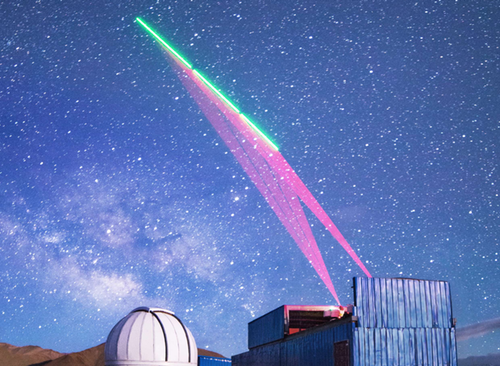
A couple of years ago I was talking about the launch of the Chinese quantum satellite Micius. During this time, he successfully paved the way to the satellite quantum Internet, demonstrating the quantum key distribution between Beijing and Vienna. The key is generated during the flight of the satellite above the ground station, the bitrate is 3–9 kb / s, which gives a key with a length from 50 to 100 kilobytes per span.
Demonstration of the quantum Internet turned out to be no less beautiful. As you remember, the first message on the radio was the name “Heinrich Hertz” repulsed by a Morsechian. Continuing the tradition, the first messages on the satellite quantum Internet were photographs of the Chinese philosopher Mo-Tzu (the satellite was named after him) and Edwin Schrödinger (who lived in Vienna).
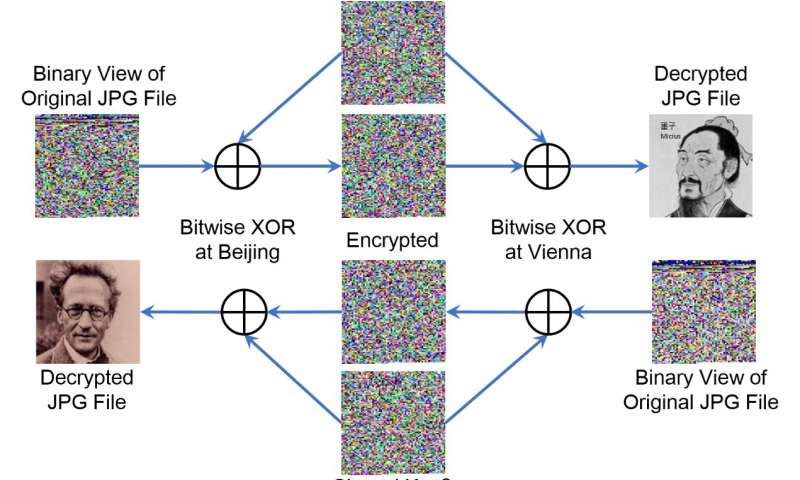
The next demonstration was the encryption of video conferencing between the academies of science of China and Austria. The video was encrypted with the AES algorithm, the 128-bit key of which changed every second. As a result, only 72 kilobytes of the secret key was used for the video conference lasting 75 minutes.
In the near future, the business of Micius will continue the new satellite. It will generate entangled photons at a wavelength of 1550 nm, where the illumination from the sun will be slightly less, and the transmittance of the atmosphere is slightly higher than at the current 850 nm. Together with new ground-based detectors (they have already been successfully tested ), this will allow receiving a signal from the satellite not only at night, but in the daytime; and launching to a higher orbit will increase the satellite visibility time. So far, everything is going as well as possible, it remains only to wish the creators of a fair wind.
The Revolution of the Year: Redefining the SI System
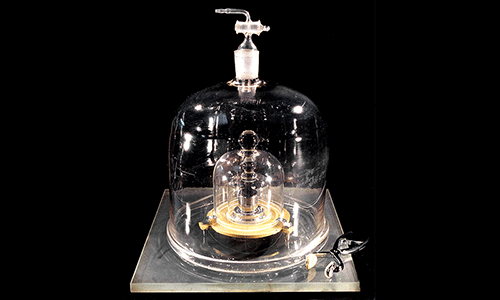
The kilogram standard - the same platinum-iridium cylinder from the Chamber of Weights and Measures - will resign on May 20, 2019. A new kilogram will be determined through one of the fundamental constants - Planck's constant. Along with it, the definitions of the Kelvin degree (which will be tied to the Boltzmann constant), ampere (expressed through the electron charge) and mole (in which there will be exactly 6.02214076 x 10 23 atoms) will change . Thus, from this moment on, all values of the SI system will be determined through fundamental physical constants.
The new system of SI units is wonderful in that we no longer measure physical quantities in convenient units, but, on the contrary, we tie units to physical entities that are the same throughout the world. For example, one meter is exactly as much as the light travels in vacuum for 1/299 792 458 seconds. The number 299 792 458 is exact, since we ourselves asked it. In turn, the second is set through two energy levels in the cesium atom, the distance between which is exactly 9,192,631,770 Hz. Thus, metrology from the worship of standards turns into a recipe: the atoms of cesium, the speed of light and Planck's constant are the same everywhere, and if you suddenly go to Mars, you can restore the whole system of units.
Video of the Year: Growing Crystal
Photographing an electron microscope with atomic resolution is no surprise to anyone. Another thing - the video, and even some! A group from Paris managed to photograph, as from an oversaturated solution, atom by atom, a gallium arsenide crystal grows layer by layer:
In principle, there is nothing new here - the features of crystal growth have long been well studied and actively used in the semiconductor industry. But the video, you see, is fascinating.
Nanotechnology of the Year: the fastest tops

Two groups - from the Higher Technical School of Zurich and Purdue University - demonstrated a way to unwind nanoparticles to speeds in excess of a billion revolutions per second. For this, nanoparticles — glass drops or dumbbells 100–200 nanometers in size — were captured into optical tweezers formed by a focused laser. If the laser polarization was circular, then the laser beam had a rotational moment that could be transmitted to the particle, thus twisting it.
Of course, the rotational moment of the photon is very small, so the unwinding went very slowly - over the course of minutes. The inhibition of nanoparticles on the ambient air also hindered, therefore, maximum speeds were achieved only in high vacuum (10 -5 millibar). But the result was impressive: at maximum speed, the centrifugal forces were close to breaking the nanoparticle, so this technology may be interesting for measuring the strength of materials. And at such speeds, the Casimir effect can manifest itself - a fundamental quantum phenomenon caused by the presence of virtual particles in a vacuum.
New year bonus: sweater with deer and its equation
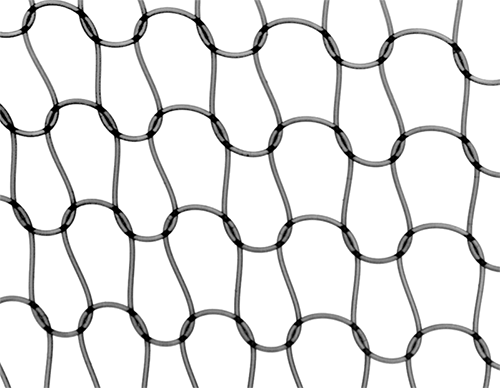
APS likes to finish the results of the year with something unusual. This time the editors liked the work on the properties of knitted fabric. We all know that the wool from the ball almost does not stretch, but a knitted sweater will easily fit you even if you have gained five kilograms after the New Year holidays. The reason for this, of course, is in the loops, which can change their shape, allowing the fabric to stretch.
Early knitted fabric models assumed that all loops were deformed more or less equally. It is quite obvious that this is not the case: if you stretch the scarf, it will strongly shrink in the middle, and almost will not shrink where you hold it. And the thread may slightly go from one loop to another, changing their perimeter.

All these questions so intrigued three scientists from France that they decided to create a neat model of knitted fabric. There were two main points: the thread is not stretchable, and the fabric tries to minimize the total energy caused by the bending of the thread in the loops. The result is a fairly simple model that describes the deformation of the loops depending on their position in the fabric. Oh yeah, in parallel with this, they tied a nylon canvas and began to stretch it in every way. Of course, it turned out that the model is remarkably consistent with the results of the experiment.
Instead of conclusion
This is how we will remember the past year. And now for the work, and we will try to make the year that has come no less interesting;).

